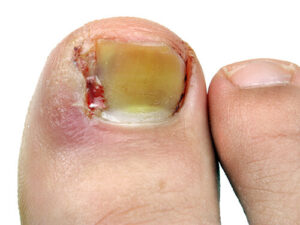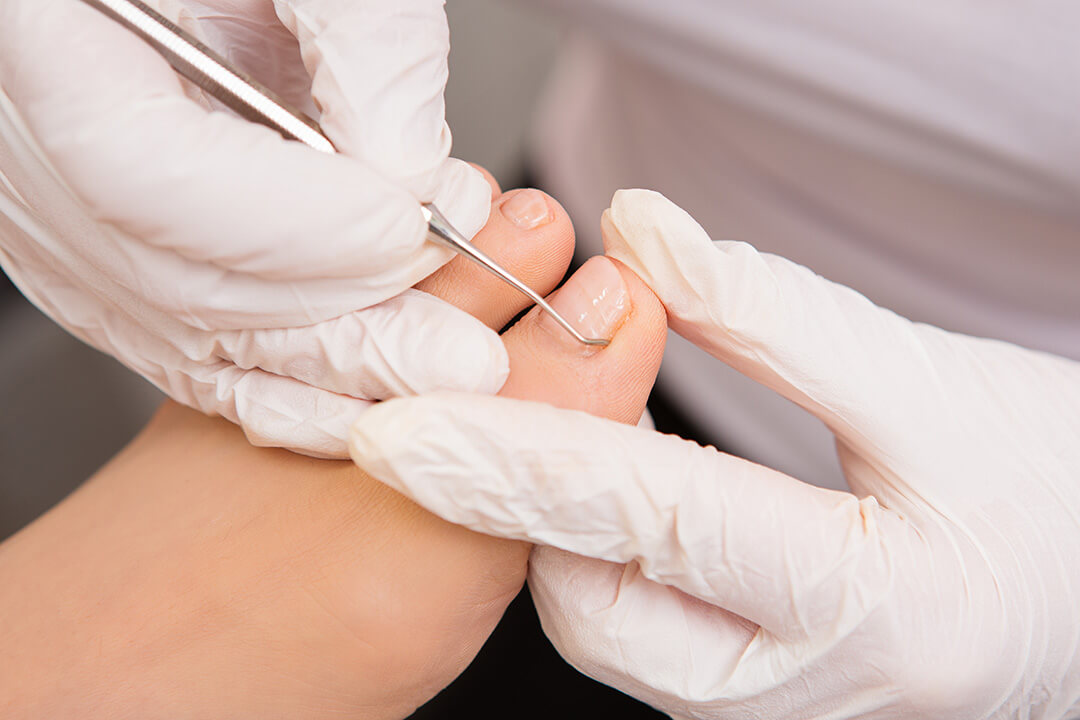We tend to take their presence for granted, but toenails serve an important role in protecting the otherwise soft tissue underneath from a myriad of mishaps. Whether due to neglect, overuse, abuse, or accidents, toenails and the surrounding skin are vulnerable to various health conditions that may be concerning.
Let’s take a look at some of the most common conditions that are seen and treated by a Professional Foot Care Nurse. This is not an exhaustive list but it will help you to decide when an appointment may be needed. If you are experiencing discomfort and are unsure of the cause, contact a healthcare professional right away.
Ingrown Toenails
 An ingrown toenail is a common condition that occurs when the corner of a toenail grows into the surrounding skin. This typically creates pain and inflammation in the area.
An ingrown toenail is a common condition that occurs when the corner of a toenail grows into the surrounding skin. This typically creates pain and inflammation in the area.
There are a few practices that can help to prevent ingrown toenails, for instance, cutting toenails straight across and not cutting them too short. But sometimes an injury to the nail can create an ingrown toenail despite other efforts.
Another factor that can cause an ingrown toenail is the toenails size and shape. People with abnormally wide or curved toenails are at higher risk for this condition.
Toenail Discoloration
Toenail discolouration is typically the least concerning of all of the common toenail conditions. The discolouration can be caused by a wide variety of benign issues.
Contact with dyes from socks and shoes can cause discoloration. Discolouration can also be caused by nail polish. After nail polish removal they can appear somewhat yellow, but this fades quickly.
Additionally, some medications can cause discoloration of the nail as well. This is usually a temporary issue. Most, if not all of medication caused toenail discoloration will self-correct. This will occur either when the use of the product or medication is stopped, or when the nail grows out.
Toenail Fungus
 Toenail fungus is a common condition with the risk of getting it increasing with age. About 50% of those 70 years of age and older will develop a fungal infection in one or more toenails.
Toenail fungus is a common condition with the risk of getting it increasing with age. About 50% of those 70 years of age and older will develop a fungal infection in one or more toenails.
Fungus starts as a spot under the tip of the toenail that spreads underneath the nail and into the nail bed. A fungal infection is generally characterized by a thickened nail or nails that can be distorted in shape, with an uneven, serrated edge that is difficult and at times painful to cut at home. Sometimes, it is accompanied by a foul odour. Fungal nails can be white, black, yellow or green in colour. If left untreated, a fungal infection can spread into the other toenails and their surrounding tissues.
Toenail fungus is highly contagious therefore, it is important to protect your feet in public areas where conditions are ideal for fungi to thrive. For instance, locker rooms, showers, and saunas are particularly hospitable to the growth of fungi.
Prolonged exposure to damp, dark conditions increases your feet’s vulnerability to fungus. Footwear that is worn for extended periods of time, without a chance to dry out between sessions, can lead to fungal infections or can worsen an already existing fungal infection.
People with diabetes are also at an increased risk for fungal toenail infections. A diabetic’s feet should be monitored regularly for fungal infections to address the condition at an early stage and to avoid it’s spread and any potential undue discomfort.
Trauma of the Toenail
 Most of us have been there – we’ve either dropped something on our toe or stubbed our toe. And it smarts, every time. These are two common types of trauma that our toes endure. The short-term use of ill-fitting shoes can cause trauma. The improper removal of jagged nails, or dead cuticles and skin around the surrounding nail tissues can also create trauma.
Most of us have been there – we’ve either dropped something on our toe or stubbed our toe. And it smarts, every time. These are two common types of trauma that our toes endure. The short-term use of ill-fitting shoes can cause trauma. The improper removal of jagged nails, or dead cuticles and skin around the surrounding nail tissues can also create trauma.
Toenails that encounter the above types of trauma will probably throb and remain painful for one or more days. The nail may turn red or purple due to blood pooling under the nail. If the nail itself is damaged it may separate from the skin. The nail may even eventually fall off.
When to call a Professional Foot Care Nurse
Sometimes all that is required for healing is time. This is often true in the case of minor toenail trauma like a stubbed toe. However, many of the conditions mentioned above may require a professional foot care nurse’s intervention.
A professional foot care nurse will ensure any issues are properly addressed for optimal pain relief and healing. They will work to prevent the condition from worsening.
Sharon Brophy is a Registered Practical Nurse who specializes in Basic, Advanced, and Diabetic Foot Care. Sharon works with patients of all ages to minimize foot discomfort and to improve their quality of life.
If you have concerns about the health of your feet, or the feet of someone in your family or in your care, contact us to book an appointment with Sharon or schedule an appointment online.

